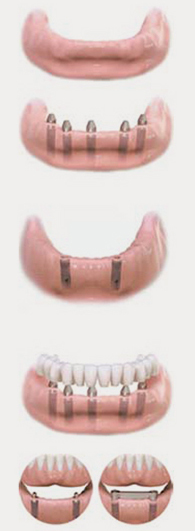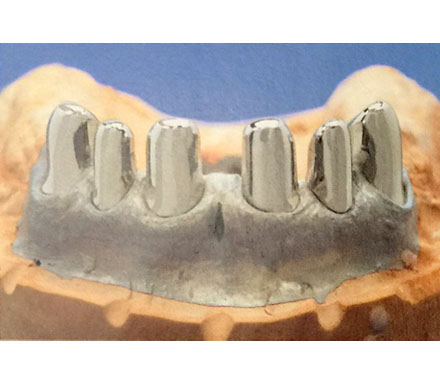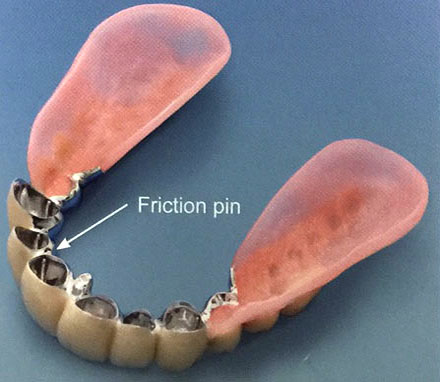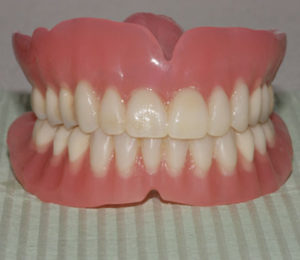If you do not have any of your natural teeth left then you will benefit from having dentures as they provide structure to your smile and prevent surrounding facial muscles from sagging. If all your teeth are missing then a complete denture is required whereas if only a few teeth need replacing, then a partial denture or over-denture can be used. Partial dentures can prevent your existing healthy teeth from shifting following tooth loss.
At times it’s possible to use the remaining teeth to provide support for denture. In this case over-denture is used. If there are no teeth remaining, dental implants can perform the support function.
This is a full removable denture and placed when the rest of the teeth are removed and gum and tissue is healed.
This type, as the name suggests, is placed immediately on the same day after all the remaining teeth are removed.
If you’re missing all of your teeth in the upper or lower jaw, a permanently anchored dental implant bridge or a removable prosthesis (connected to two or more dental implants) is the right solution for you. This is called an overdenture. This type of denture remains securely in place, more so than a conventional removable prosthesis.
Implant-supported dentures and full bridges will replace some of your tooth roots, therefore saving the jawbone. Dental implants bond with your jawbone, keeping the bone healthy and intact. With conventional dentures, bone slowly starts to disappear, over time it may impact the shape and form of the jaw. Over years, the denture may need remodelling so that it fits the changing shape of the jaw.
Dental implants become part of you as they integrate completely with your jawbone, restoring chewing and biting function. The result is increased comfort and confidence when eating and speaking. Bone loss causes the denture to move and slip, making it increasingly difficult to stabilise. Irritation and inflammation are common among denture patients. The remaining bone may not be enough to protect the jaw nerves from the pressure of biting and chewing. This type of pressure may cause extreme pain and discomfort.
Dental implants, like your natural teeth, need regular brushing, flossing and dental hygiene visits. The cement holding bridges in place can wear off, allowing bacteria to penetrate and cause decay.
Implant-supported bridges replace teeth lacking support from adjacent natural teeth. Fixed bridges or removable partial dentures are dependent on support from adjacent teeth.
In the long term, implants can be more aesthetically pleasing and easier to maintain than conventional dentures. The loss of bone that accompanies conventional dentures leads to recession of the jawbone and a collapsed, unattractive smile.

The dentist makes a small incision to access the jawbone. The dentist then drills a small hole and inserts the screw-like implants. The incision is closed, 3 – 6 months is given for the bone and implants to bond together. This process is called “osseointegration”. During this period, your dentist will prepare temporary tooth replacements for cosmetic purposes.
For a permanently anchored dental implant bridge, several implants are installed to form a good foundation. Since the dental implants are anchored in the jawbone they stimulate the bone tissue, maintaining healthy bone levels and facial structures. An overdenture involves installing two or more dental implants used as a secure foundation to attach the prosthesis.
The abutments are attached to the dental implants and the bridge is fitted in place. All dental work is performed according to your prerequisites and wishes. For the overdenture, either ball abutments or a small bar between the abutments are/is used. The prosthesis is fitted with corresponding devices underneath.
The dental implant bridge, or the overdenture, is now in place. It looks and functions like normal teeth. You can now eat whatever you like and laugh without having to worry about the prosthesis falling out.
The telescopic denture is an affordable alternative at half the cost to implant dentures or All-on-4, they can be made faster than any other treatment.
This system requires that patients have enough teeth in their mouth or enough bone to place implants to place a denture with the telescopic denture technique over the crown, natural teeth or dental implants. A telescopic denture is removable and allows for ease of cleaning and repair if required.



The dentures are held in place using telescopic crowns on your own teeth or implants without any hooks. They were invented in Germany by Professor Koerber in 1968 as a German precision partial denture (without clips). In most cases, telescopic dentures don’t affect your speech.
The remaining teeth are prepared with a drill so that a crown can be fitted over the tooth. This crown is in the shape of a cone with a 5° taper, and not the normal bell shape of a natural tooth. This crown is technically called a primary crown and it is permanently cemented over the prepared tooth.
One telescopic crown or an inner cap is cemented permanently onto your tooth or abutment of the implant (in these situation abutment are made as inure crown over implants), the other outer cap on top looks like your teeth and combines with your denture. If you can imagine two cups representing the two crowns being stuck together, when you pull them apart you feel resistance. The telescopic denture is held in place with friction technology.
If a sufficient number of secondary crowns (at least 6 ) are incorporated into the body of the denture there is no need to cover the palate (roof of the mouth).
Telescopic Dentures can be fitted to a few remaining teeth but need the support of a minimum of two teeth per jaw. Ideally, one on each side, usually only between 2-6 teeth are required. The denture may also extend to 6 -8 teeth. It depends on the condition of your teeth. If you lose teeth later or years down the track, teeth can be added to the dentures, so there is no need for new dentures to be remade.
If you have only dental implants, the abutment over implant can be made as cone crown, the telescopic dentures can be attached to those implants. Telescopic Dentures classically fit to cone crowns on natural teeth but can also fit to abutments on implant fixtures. See the case below
This case is a combination of patient’s their own remaining two teeth in lower jaw and two implants with telescopic crown.
This is a really affordable alternative at half the cost to implant dentures or All-on-4. Even better, they can be made in a few weeks.
This fixed but removable telescopic denture allows for ease of cleaning and simplicity of denture repair if required. This video below will give you a better understanding of how this denture technology works. Because the plate itself is made from Chrome Cobalt, which is a high bio-compatible material, it’s accepted by the body and not rejected. This has been used in dentistry and medicine for many decades. In telescopic dentures it’s been used since 1982 and it’s a good strong material. The actual teeth are made out of composite, so the colour can be made to suit or match any desired colour.
The cone crown is made from a variety of materials including cast stainless steel and zirconium. A secondary crown made of the same material is designed to frictionally fit intimately over the cone crown and is incorporated into the telescopic denture.
You need the right team of dental technicians and dental specialist to have the perfect fit. Home oral care is an crucial aspect of longevity of your treatment . You must make sure that you regularly see Hygienist and dentist for regular maintenance and review if you are interested please call us on 020283399333
 Conventional dentures are made after the remaining teeth have been removed, and the gum has healed. The denture can be placed about 8-12 weeks after the teeth extraction. Conventional dentures can be partial of full denture.
Conventional dentures are made after the remaining teeth have been removed, and the gum has healed. The denture can be placed about 8-12 weeks after the teeth extraction. Conventional dentures can be partial of full denture.
Unlike conventional dentures, immediate dentures are made prior to tooth extraction and placed in as soon as the teeth are removed, therefore the patient will not be without teeth during the healing period. Despite that, since the bone and gum will shrink particularly during the healing period, the imm
 Dr. Simin Soltani (Principal dentist)
DDS . MSC . Sweden
Dr. Simin Soltani (Principal dentist)
DDS . MSC . Sweden
Please get in touch if you are concerned about any aspect of your dental health. We will treat you fairly and honestly - and we look forward to being able to help you.
